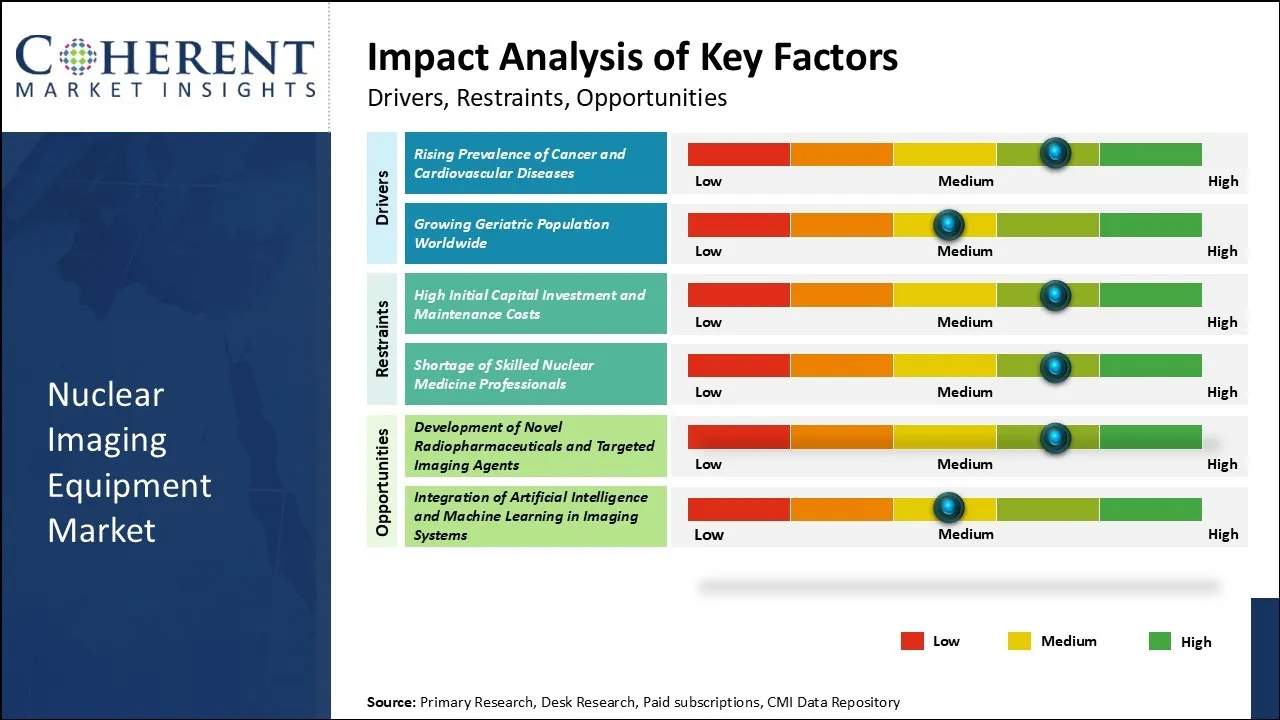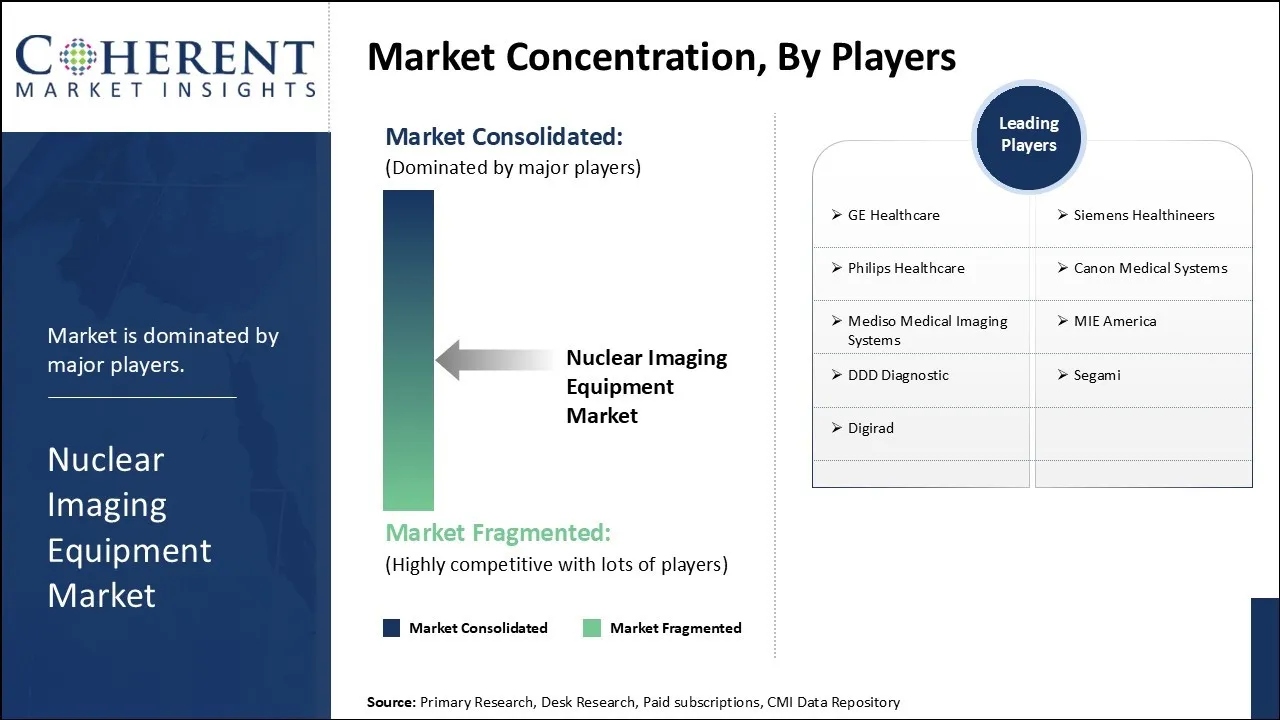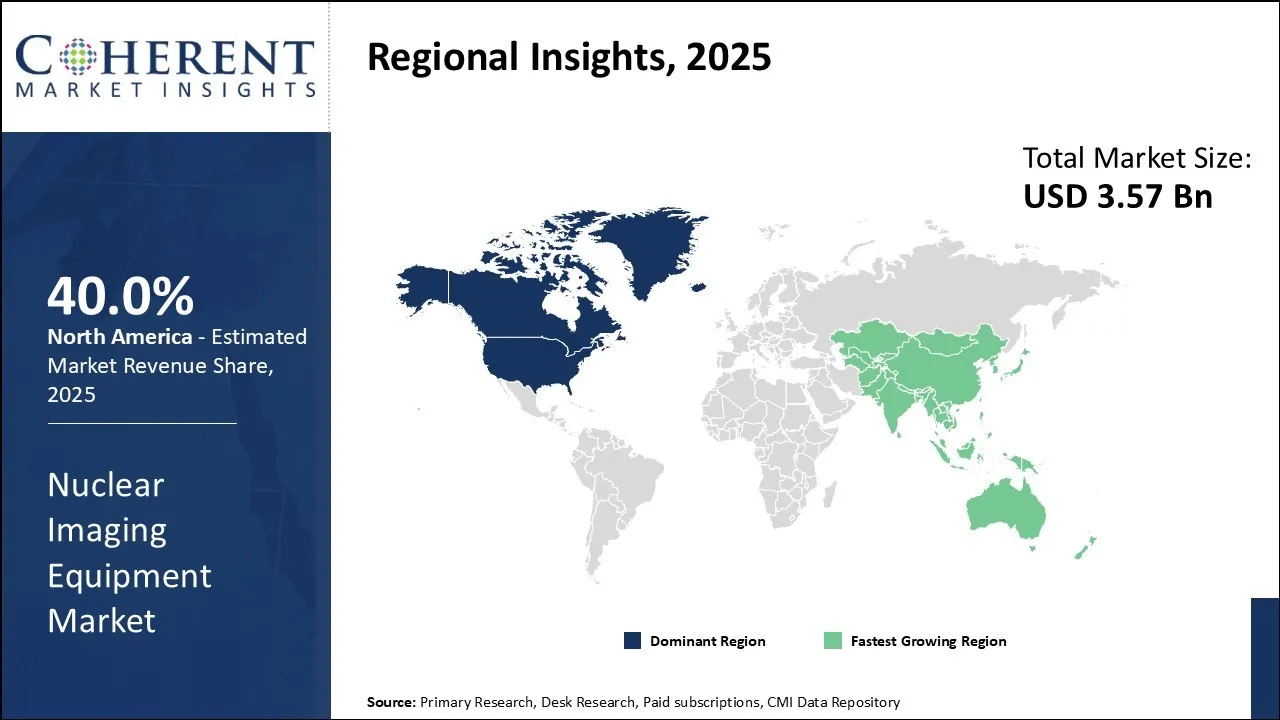The nuclear imaging equipment market is estimated to be valued at USD 3.57 Bn in 2025 and is expected to reach USD 5.06 Bn by 2032, exhibiting a compound annual growth rate (CAGR) of 5.1% from 2025 to 2032.

To learn more about this report, Download Free Sample
Nuclear imaging devices are the devices which are commonly employed in radioactive materials to assess the severity of illnesses including cancer, endocrine, gastrointestinal, cardiovascular, neurological, and other brain disorders. By providing operational data at the molecular and cellular levels, these non-invasive devices help clinicians to assess and diagnose medical issues. In the field of nuclear imaging, Positron Emission Tomography (PET) systems, single photon Emission Computed Tomography (SPECT) systems and planar scintigraphy are the main product categories.
However, the exorbitantly high cost of nuclear imaging modalities and equipment is a major factor hampering the growth of the nuclear imaging market globally.

To learn more about this report, Download Free Sample
|
Current Events |
Description and its impact |
|
Geopolitical Developments in Key Countries |
|
|
Regulatory and Safety Standards Evolution |
|
Uncover macros and micros vetted on 75+ parameters: Get instant access to report
The escalating incidence of cancer and cardiovascular diseases worldwide is fundamentally transforming the nuclear imaging equipment landscape, creating unprecedented demand for advanced diagnostic solutions. Cardiovascular diseases, which the WHO identifies as the leading cause of death globally accounting for approximately 17.9 million deaths annually, are similarly propelling the demand for nuclear cardiology imaging equipment.
For instance, the World Health Organization projects that new cancer cases will rise from an estimated 20 million in 2022 to over 35 million by 2050, marking a 77% increase. This surge is driven by population aging and growth, as well as increased exposure to risk factors associated with socio-economic development such as tobacco use, alcohol consumption, obesity, and air pollution.
The Single Photon Emission Computed Tomography (SPECT) segment is expected to contribute the highest share of 35.0% in 2025. SPECT technology has been a cornerstone in nuclear imaging for several decades, making it a trusted and widely adopted diagnostic tool in hospitals and diagnostic centers globally.
Its ability to provide three-dimensional functional information about tissues and organs plays a critical role in cardiology, oncology, and neurology. For example, SPECT is extensively used in myocardial perfusion imaging to assess coronary artery disease, which remains a leading cause of mortality globally.

To learn more about this report, Download Free Sample
North America has established itself as the dominant region with an estimated market share of 40.0% in 2025 in the global nuclear imaging equipment market. The region's dominance is exemplified by the extensive network of academic medical centers and research institutions that continuously drive innovation in nuclear imaging technologies.
For instance, the Mayo Clinic has been at the forefront of implementing advanced PET-CT scanners and SPECT imaging systems, contributing to improved patient outcomes in oncology and cardiology diagnostics. The Cleveland Clinic has similarly invested in state-of-the-art hybrid imaging systems that combine nuclear medicine with other modalities, enhancing diagnostic accuracy for complex cardiovascular conditions.
The Asia Pacific region is expected to be the fastest-growing market for nuclear imaging equipment market, with a CAGR of over 6.1% during the forecast period. Driven by unprecedented technological adoption rates and expanding clinical applications, particularly in emerging markets experiencing rapid healthcare sector transformation.
Furthermore, Vietnam's healthcare modernization initiative has led to remarkable expansion in nuclear medicine capabilities, with the Vietnam Atomic Energy Institute documenting the establishment of 15 new nuclear medicine departments in major hospitals between 2020 and 2023, representing a significant leap in diagnostic imaging infrastructure.
The U.S. leads the global nuclear imaging equipment market due to strong healthcare infrastructure, extensive adoption of PET and SPECT technologies, and significant R&D investment by companies like GE HealthCare and Siemens Healthineers. The presence of leading research institutions and favorable reimbursement policies also drive innovation and clinical integration.
Germany dominates the Europe nuclear imaging equipment market with its advanced medical imaging infrastructure and strong focus on early diagnosis and precision medicine. It serves as a key hub for clinical trials, medical device manufacturing, and academic-industry collaborations, reinforcing its leadership in nuclear imaging technology development.
China is rapidly emerging as a dominant force due to heavy investment in healthcare modernization, increased cancer screening initiatives, and domestic manufacturing of nuclear imaging systems. Strategic partnerships, infrastructure development, and expanding medical imaging facilities in tier-2 and tier-3 cities contribute to its market acceleration.
Japan is a major player in the Asia Pacific nuclear imaging market, driven by its aging population and high prevalence of chronic diseases like cancer and cardiovascular disorders. The country is known for its early adoption of hybrid imaging systems and consistent government support for advanced diagnostic technologies.
|
Equipment Category |
Typical Price Range (USD) |
Leading Brands & Models |
|
SPECT Scanners |
400,000 –1.2 million |
GE Healthcare (NM/CT 870 CZT), Siemens Healthineers (Symbia Intevo) |
|
PET Scanners |
1.2 million –3 million |
Siemens Biograph mCT, GE Discovery MI, Philips Vereos |
|
PET/CT Hybrid Systems |
2.5 million –5 million |
GE Discovery MI, Siemens Biograph Vision, Philips Ingenuity TF |
|
PET/MRI Systems |
6 million –10 million and above |
Siemens Biograph mMR, GE SIGNA PET/MR |
|
Radiopharmaceutical Injectors |
80,000 - 150,000 |
Cardinal Health, Comecer Model Integra |
Uncover macros and micros vetted on 75+ parameters: Get instant access to report
| Report Coverage | Details | ||
|---|---|---|---|
| Base Year: | 2024 | Market Size in 2025: | USD 3.57 Bn |
| Historical Data for: | 2020 To 2024 | Forecast Period: | 2025 To 2032 |
| Forecast Period 2025 to 2032 CAGR: | 5.1% | 2032 Value Projection: | USD 5.06 Bn |
| Geographies covered: |
|
||
| Segments covered: |
|
||
| Companies covered: |
GE Healthcare, Siemens Healthineers, Philips Healthcare, Canon Medical Systems, Mediso Medical Imaging Systems, MIE America, DDD Diagnostic, Segami, and Digirad |
||
| Growth Drivers: |
|
||
| Restraints & Challenges: |
|
||
Uncover macros and micros vetted on 75+ parameters: Get instant access to report
*Definition: Nuclear imaging devices are commonly employed in radioactive materials to assess the severity of illnesses including cancer, endocrine, gastrointestinal, cardiovascular, neurological, and other brain disorders is called a nuclear imaging device. By providing operational data at the molecular and cellular levels, these non-invasive devices help clinicians assess and diagnose medical issues. In the field of nuclear imaging, PET systems, SPECT systems, and planar scintigraphy are the main product categories.
Share
Share
About Author
Manisha Vibhute is a consultant with over 5 years of experience in market research and consulting. With a strong understanding of market dynamics, Manisha assists clients in developing effective market access strategies. She helps medical device companies navigate pricing, reimbursement, and regulatory pathways to ensure successful product launches.
Missing comfort of reading report in your local language? Find your preferred language :
Transform your Strategy with Exclusive Trending Reports :
Frequently Asked Questions
Joining thousands of companies around the world committed to making the Excellent Business Solutions.
View All Our Clients